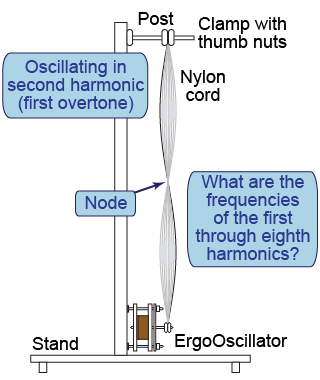|
| Essential questions | | What do we mean by the wavelength of a wave?
How can a wave have a length? | |
|
A standing wave is a wave that has been trapped between two boundaries, such as the fixed ends of an elastic string. Because standing waves persist for long periods of time they make an excellent example for investigating wavelength and frequency. 
|
Part 1: Setting up a standing wave

- Launch the interactive simulation of a vibrating string driven by an oscillator.
- Change the oscillation frequency until you create a standing wave.
- Change the frequency to see different standing wave patterns with different numbers of nodes and antinodes.
- Do the standing waves appear at all frequencies or just specific ones? Explain this using the idea of resonance.
- Describe the role of reflection and interference in creating standing waves.
- Sketch two or three different standing wave patterns and indicate the wavelength of each.

|
|
In this interactive simulation you will change the frequency of an oscillator to create standing waves in a string. Can you find the fundamental frequency of oscillation? The harmonics? You can also change the tension on the string or its thickness (its mass per unit length) and then see how the frequency of resonance varies.
|
Part 2: Relationship between wavelength and frequency
- Adjust the frequency until you get the largest amplitude standing wave you can that has a single node between its fixed ends. This is the second harmonic because there are two antinodes.
- Using the measuring scale, estimate the wavelength of the standing wave and record its wavelength and frequency.
- Adjust the frequency to find the standing waves for the first through the eighth harmonics and record the wavelength and frequency of each.
- What is the relationship between frequency and wavelength? State it with a mathematical formula.
- What units does the product of frequency × wavelength have? What is the interpretation of this quantity?
- How could you control the frequency of a vibrating object through its wavelength? Describe at least two applications of this principle.
- Going further: What happens to the fundamental frequency of the standing wave if you quadruple the tension in the string? What happens to the fundamental frequency if you quadruple the mass/length of the string?

|
Conducting the investigation with the ErgoOscillator
 You can conduct the same experiment using the ErgoOscillator connected to one end of an elastic cord.
You can conduct the same experiment using the ErgoOscillator connected to one end of an elastic cord. - Clamp the elastic cord between the oscillator and top post. Use a spring scale to set the tension to 1 N.
- Adjust the frequency until you get a standing wave.
- Change the frequency to see different standing wave patterns with different numbers of nodes and antinodes.
|

